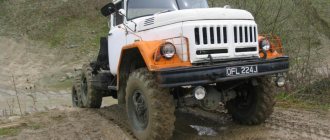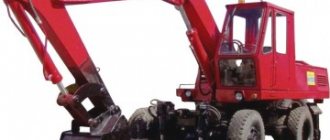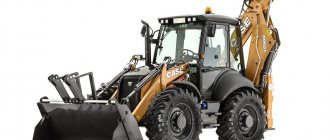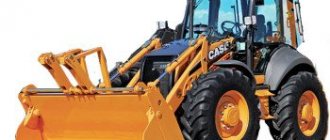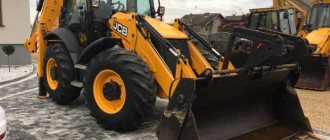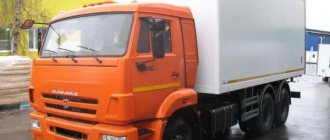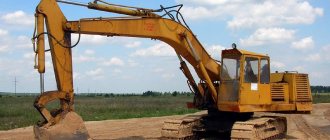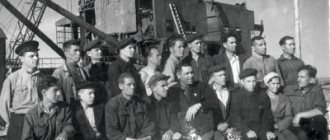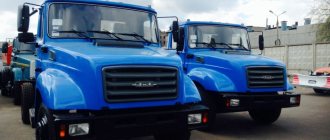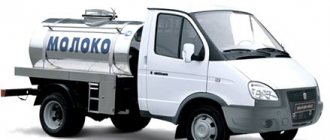The 3323 excavator, developed by VNII Stroydormash, is a universal earth-moving machine. The equipment has been mass-produced since 1983 by a specialized enterprise located in the city of Kalinin (now Tver). There are excavators assembled by a plant in Kentau (Kazakhstan). Later, both companies produced a modernized version of the 3323A, equipped with a souped-up engine and modified working equipment.
general information
The EO-3323 excavator is most often used for digging pits, trenches, and loading rocky and frozen soil into a dump. The design of the equipment allows it to be used in urban environments and in open areas. Serial production of this model has been discontinued, but it continues to be widely used.
The EO-3323 excavator is classified as a single-bucket dredging machine. The equipment moves on wheels, which simplifies the process of transportation to the workplace. One of the main positive qualities of a tractor is its durability. According to the technical documentation, the unit has a working life of 8 thousand hours without major repairs. The machine can be operated in the most difficult conditions. Statistics show that equipment can operate up to 14 thousand hours without serious breakdowns.
Modifications
There are several modifications of the equipment; the main distinguishing features of each model are the hydraulic system and motor. The latter can be installed foreign or Russian-made. The foreign unit is characterized by higher power, efficiency and long periods between maintenance.
| Model | EK-18-20 | EK-18-30 | EK-18-60 | EK-18-90 |
| Engine | MMZ 245S | Perkins 1104C-44TA | D-245 2S2 | |
| engine's type | Diesel, liquid cooling | |||
| Engine power, hp | 105 | 123 | 122 | |
| Hydraulics | PSM | Bosch-Rexroth | ||
| Handle, m | 2,2/,2,8/3,4 | |||
| Bucket capacity, cubic meters m | 1,0/0,7/0,65 | |||
| Digging depth | 5,77/6,37/6,97 | |||
| Unloading height, m | 6,24/6,5/6,75 | |||
| Cycle duration, s | 18,5 | |||
| Travel speed, km/h | 20 | |||
| Overall dimensions, mm | 9360/2500/3158 | |||
| Equipment weight, t | 18,4 |
EK-18 modifications:
- standard model EK-18;
- TVEX EK-18-20 is characterized by increased efficiency; a standard working element (bucket) with a capacity of 1 cubic meter is installed on it. m. All equipment components are produced in Russia. The main frame has a reinforced structure, which guarantees high performance when working in harsh conditions. TVEX 18-20 can be equipped with a large number of additional working parts. This modification is considered the most powerful and multifunctional;
- EK-18-30 is the previous model with an improved foreign-made hydraulic system;
- The EK-18-40 has a clamshell grab as a working tool as standard. This special equipment is most often used in logging and scrap metal processing plants. Optionally, this model can be equipped with a lifting cabin (using hydraulics) and a scrap body;
- EK-18-44 is an improved version of the previous model. A hydraulic lifting cabin, a scrap organ, a five-jaw grab with a capacity of 0.65 m3, and a full-rotary rotator are standardly installed here. Its main purpose is loading and unloading of gondola cars, as well as work for which the EK-18-40 modification is intended;
- TVEX EK-18-60 is equipped with a hydraulic propulsion motor jointly produced by Bosch and Rexroth, a hydraulic pump, and a power unit manufactured by Perkins;
- EK-18-90M is the latest development of the manufacturer, in which axles with limited slip differentials are installed, which improves the ability to overcome difficult areas. The steering wheel made in Italy is smaller in size, which creates more comfortable working conditions for the operator. In addition, the cabin has increased rigidity. The power plant is characterized by increased power indicators, which has a beneficial effect on the efficiency of the equipment. Optionally, handles of various sizes are installed; 2.2 m is used as standard. Increasing its length promotes deeper digging, but the capacity of the working body is reduced.
Technical characteristics of the EO-3323 excavator
Below are the main parameters of the modification in question:
- Type of power unit - diesel engine type D-243.
- Power indicator - 81 hp. With.
- The pressure in the hydraulic system is 28 MPa.
- The operating cycle duration is 16 seconds.
- Travel speed - 20 km/h.
- The main working tool is a backhoe with a bucket with a capacity of 0.65 cubic meters.
- Weight with equipment - 12.4 tons.
- Unloading height - 5.63 m.
- The frame is of welded type.
- Stable platform on pneumatic wheels.
General equipment design
The chassis of the EO-3323A excavator is based on a box-section running frame, on the top of which a rotating device is installed. There are two folding supports at the rear of the frame, and a blade is mounted at the front. The supports are equipped with individual hydraulic cylinders, the blade is driven by 2 cylinders. The control units are separate and placed in the driver’s cab.
The rotating device includes a roller ring equipped with a toothed ring with internal gearing. The assembly includes sealing gaskets that protect the rolling surfaces from contamination. For turning, an axial piston hydraulic motor is used, equipped with an additional 2-stage planetary gearbox. The use of a gearbox made it possible to reduce the rotation speed of the platform and increase the torque.
The rotating part of the excavator has a welded space frame equipped with points for installing components and equipment. The power unit, hydraulic drives and the driver’s cabin are mounted on the rotating part. Early models of the excavator use a 4-cylinder liquid-cooled diesel engine D-240, developing a power of 75 hp. c. The working volume of the cylinders is 4750 cm³. The engine is started using an electric starter or using a separate gasoline engine. Later, the D-243 unit, with a power of 81 hp, began to be used. With.
The engine is equipped with a friction clutch for connecting a 3-section hydraulic axial piston pump. The pump drive includes a gearbox that distributes the torque among sections. The device includes 2 main adjustable sections and an additional non-adjustable module. The total pump capacity is 265 liters of liquid per minute at a pressure of 25-28 MPa.
Oil is supplied to consumers through multi-section spool valves. To cool the oil, there is a radiator equipped with forced air supply from a fan. Power is taken to the impeller from the pump unit.
The engine has a separate gear pump used to drive auxiliary equipment.
To move the excavator, an axial piston type hydraulic motor is used, additionally equipped with a 2-speed manual gearbox. Gear shifting is performed from the driver's cab. The rear axle is equipped with a main pair with a differential mechanism and additional planetary gearboxes. The front axle design includes steering knuckles. The axles are connected to the manual transmission using cardan shafts. The front axle is equipped with a special device that allows you to disable the transmission of torque to the wheels.
The direction of movement is controlled by hydraulic cylinders and a lever system. The rods are connected to a worm gearbox equipped with a car-type steering wheel. When towing an excavator, the drawbar is connected to a special carrier, ensuring that the wheels of the front axle rotate when passing curves in the road. Drum-type brake system with pneumatic pad drive. Braking is controlled by a pedal from the driver's workplace.
The machine is equipped with a pneumatic system. Compressed air is used to control the brakes, transmission and to disable the front axle drive. The air source is a compressor driven by the main engine. The system includes receivers equipped with condensate drain points.
The driver's cabin and the hood of the power plant are of metal construction. The power plant casings consist of several removable elements with additional hatches. The cabin has a coating that reduces noise and vibration levels. Access to the cabin is through a side door equipped with a lock. A bracket is installed to secure the door in the open position.
Ventilation is carried out through a folding windshield or forced by a fan. Some copies of recent years of production were equipped with air conditioning. In winter, the cabin is heated by air flow passing through a radiator, which is connected to the cooling system. The driver's seat is sprung and equipped with a mechanism for adjusting the angle of the backrest.
Advantages and disadvantages
Among the advantages of the EO-3323 excavator, the following points are noted:
- Operational reliability.
- Comfortable control of attachments.
- Special vibration protection.
- High-precision operation of hydraulic equipment.
- The presence of a special sensor that allows you to monitor the shift in the placement of devices while moving.
- A pair of folding supports guaranteeing complete stability of the equipment during operation, taking into account the large dimensions of the model.
The disadvantages include an obsolete design, high fuel consumption, low level of operator comfort, and the lack of an air purification system and air conditioning.
Advantages and disadvantages
The advantages of the machine are:
- simplicity of design and repair;
- possibility of long-term work;
- universal design, adapted to install additional equipment;
- chassis stability due to the use of hydraulic supports;
- accuracy of positioning of working bodies;
- chassis on pneumatic tires reduces vibration levels during operation;
- ability to move independently on public roads.
The disadvantages of the excavator include the following:
- the operator's cabin does not have an air conditioning system (on most machines);
- poor quality seals, which allows dust and exhaust gases to enter the cabin;
- low quality of spare parts.
Design features
In its standard version, the Kalininets EO-3323 excavator is equipped with a diesel power unit located on the right side of the platform. For regions with mild climates, a D-75P1 configuration motor with an electric drive is installed, which makes it possible to start the unit directly.
The enhanced hydraulics of the EO 3323 excavator makes control as simplified as possible. The cabin is equipped with a pair of vertical posts, a conveniently placed control panel, and a rounded steering wheel. This configuration ensures that manipulation is carried out quickly and accurately.
Despite the fact that the engine power is only 75 “horses”, the speed limit of the car reaches 20 km/h. Such parameters ensure that the tractor can be transported to the work site under its own power. Improved modifications are equipped with a reinforced engine with a power of 81 hp. With.
Video
This equipment, which has a wide range of functions, can be used in open areas and in the city. again, the model works flawlessly in a wide temperature range (from -40 to +40 degrees).
The main and auxiliary equipment of EO-3323A includes:
- hydraulic shears;
- equipment for concrete destruction (concrete breaker);
- hydraulic hammer;
- backhoe with a 0.65 cubic meter bucket;
- equipment for loosening and crushing soil;
- specialized grab.
The popularity of the model on the Russian market is due to its reliability, ease of operation and ease of maintenance, which have stood the serious test of time.
Working systems
The EO-3323 excavator, the characteristics of which are given above, in the second generation has an improved design, the elements of which have high productivity with low specific material consumption and increased driver comfort.
The car received a significant improvement thanks to the introduction of updated systems. Hydraulics of equipment includes several components and assemblies, namely:
- Hydraulic motors.
- Built-in pump.
- A pair of distributors with four spools.
- Additional monoblock synchronizer.
- Line and filling filters with a processing level of 25 microns.
- Oil cooler.
- Steering with hydraulic metering type.
- Pipelines.
- Storage tank.
- Automatic protective systems.
As a result of modification of the design, the performance of the hydraulic system increased, the maximum pressure increased to 28 MPa. The performance indicator was 60 liters per minute. Such parameters are considered high-performance for that period. All of these points made it possible to reduce the weight of the machine.
In 1983, the Kalinin Excavator Plant mastered mass production of the new single-bucket universal hydraulic excavator EO-3323 on pneumatic wheels, the design of which was created by the plant together with VNIIstroydormash. The EO-3323 excavator is designed to perform excavation and loading and unloading work (depending on the working equipment and working parts used) in industrial, urban, rural, land reclamation and transport construction conditions. This excavator is the first machine in the second generation 3rd generation hydraulic excavator family. It is expected that this family will also include crawler-mounted excavators with a regular and enlarged supporting surface. The main task in creating second-generation hydraulic excavators is to further increase their productivity, reduce specific material and energy consumption, increase the service life and improve the design of a number of assembly units, and improve the working conditions of the driver. A significant increase in productivity is achieved by increasing the capacity of the buckets by increasing the forces on the cutting edge while increasing the maximum pressure in the hydraulic drive to 28 MPa versus 17.5 MPa for the first generation EO-3322B excavator currently being produced. Increasing the pressure in the hydraulic drive and improving the design of a number of units also made it possible to reduce the operating weight of the EO-3323 excavator by 500 kg compared to the EO-3322B excavator.
Technical characteristics of the EO-3323 excavator
Engine make
| D-240 or D-240L | |
| Engine power, kW | 55,2 |
| Rotation speed, s-1 | 37 |
| Maximum speed, km/h | 19,4 |
| Tire size | 12,0 — 20 |
| Pressure in the hydraulic pipeline, MPa | 28 |
| Pump flow 234.20 (333.20), l/min | 2 x 116 + 60 |
| Maximum cutting force, kN | 100 |
| Cycle duration when working with a backhoe/forward shovel with a capacity of 0.63 m3, s | 16,5 / 15,9 |
| Overall dimensions, mm: | |
| ..length | 7550 |
| ..width | 2500 |
| ..height | 3700 |
| Operating weight with backhoe equipment and bucket with a capacity of 0.63 m3, t | 14 |
straight shovel
| Bucket capacity, m3 | 0,63; 1,2 |
| Maximum digging radius, m | 6,78 |
| Maximum digging/unloading height, m | 7,66 /4,2 |
Backhoe
| Bucket capacity, m3 | 0,5 | 0,63 | 0,8 |
| Maximum digging depth, m | 5,4 | 4,5 | 4,5 |
| Maximum digging radius at parking level, m | 8,5 | 7,75 | 7,75 |
| Maximum unloading height, m | 4,9 | 4,7 | 4,7 |
Grab
| Bucket capacity, m3 | 0,5; 0,63 |
| Maximum digging depth without extension inserts, m | 5,4 |
| Maximum unloading height, m | 3,89 |
working equipment is made of low-alloy steel and has increased strength, allowing it to be used with a wide range of various replaceable working parts of both static and impact action. The working equipment of the backhoe has a boom of a monoblock design and two handles of different lengths. The replaceable working parts are: a bucket with a capacity of 0.5 m3 (type 02 according to OST 22-915-76) for soils of categories I - IV, designed to work with the main and extended handles; a bucket with a capacity of 0.63 m3 (type 02) for soils of categories I - IV and a bucket with a capacity of 0.8 m3 (type 03) for soils of categories I - II, designed to work with the main handle. The working equipment of a straight shovel includes a boom and a handle and has replaceable working parts: a bucket with a capacity of 0.63 m3 for soils of categories I - IV and a loading bucket with a capacity of 1.2 m3 (according to GOST 16391-70) for materials with a density of up to 1.4 t/m3. The working equipment of a hydraulic hammer is assembled from elements of a backhoe (monoblock boom and handle), onto which a working element with replaceable tips for loosening frozen soils, crushing stones and breaking up road surfaces or tamping plates for compacting soils is hung. The design of the excavator allows the use of many other replaceable types of working equipment and working parts, a significant part of which has already been tested on the EO-3322A and EO-3322B excavators, and auger drilling and lifting equipment will be created in the near future. The EO-3323 excavator differs from its predecessor, the EO-3322B excavator, in the design of a number of new units and original layout. on a rotary platform of a welded structure, consisting of a diesel engine and a pump connected by a friction clutch, which allows the engine to be started when the pump is turned off. The power plant is located along the rotating frame and is easily accessible from both sides. It is possible to install the D-240 engine with direct electric start or D-240L with electric start of the starting engine. The platform rotation mechanism is made in the form of a two-stage planetary gearbox driven by a 210.25 hydraulic motor. The hydraulic drive includes a triple pump, two four-spool monoblock hydraulic valves, a spool servo control system, hydraulic motors and hydraulic cylinders, linear and filling filters with a working fluid filtration fineness of 25 microns, an oil cooler with a fan driven by a hydraulic motor, a steering system with a hydraulic metering motor, pipelines, a hydraulic tank , protection and automation elements. The pneumatic wheel drive (with a 4X4 wheel arrangement) is equipped with two folding supports located at the rear and a dump support located at the front. Each folding support is controlled by its own hydraulic cylinder, and the blade support, which performs the functions of both a supporting element and a working element, is driven by two paired hydraulic cylinders. The pneumatic wheel frame is welded, box-section. The travel mechanism transmission is driven from a 310.25 hydraulic motor through a two-speed gearbox and cardan shafts to the rear unsteered and front steered axles. The newly designed axles include a bevel final drive, bevel differential and hub planetary gears. The wheel drive is equipped with shoe brakes controlled by a pneumatic system. The driver's cabin has increased rigidity due to the introduction of two vertical front pillars in the side walls. It is equipped with a heater, rear-view mirror, windshield wiper, sun visor, fire extinguisher, first aid kit, thermos, and a shock-absorbing seat that allows you to adjust the seat in vertical and horizontal directions. The cabin contains two servo control panels for the main mechanisms of the excavator, servo control panels for auxiliary elements and control devices. The excavator is equipped with a towing mechanism that allows it to be transported on a trailer behind a car. In this case, the transportation speed can be increased to 50 km/h. The tests carried out confirmed the good performance of the machine, the reliability of mechanisms and metal structures, ease of operation and maintenance. During testing, the operational productivity of an excavator equipped with a backhoe with a bucket with a capacity of 0.63 m3 was 104 m3/h; time to transfer the excavator from the working position to the transport position is 3.5 minutes; operational labor intensity of shift maintenance is 0.58 people/hour. The lifespan before the first overhaul of the EO-3323 excavator is 8 thousand engine hours.
Eng. V. N. GRYAZNOV (Kalinin Excavator Plant), Ph.D. tech. Sciences A.V. RANNEV and Eng. V. K. GOIKHBURG (VNIIStroydormash)
Chassis
The excavator in question is placed on a fully rotating platform with pneumatic wheels. The base has an elongated boom with a handle, which is connected to the working body. The platform rotates using a hydraulic drive and a dual-mode planetary gearbox.
The chassis is a welded metal structure with a 4x4 wheel arrangement. The front part of the front axle is controlled; two retractable supports are installed on the chassis. A bulldozer blade is placed at the front, acting as a third support; the design of the device allows it to be transported at a speed of 50 km/h.
Equipment
Technical characteristics of EO 3323 assume the following basic configuration of the unit:
- L-shaped hydraulic boom;
- Loading bucket;
- Backhoe for soils of categories 1 – 2;
- Backhoe, for soil categories 3 – 4;
- Straight shovel.
Additional attachments include:
- Grab;
- Hydraulic hammer with an additional set of tips;
- Concrete breaker;
- Special hydraulic shears;
- Ripper;
- Vibrating plate;
- Lifting equipment;
The design feature is that all attachments are attached to the front of the excavator.
The EO 3323 excavator is less functional compared to backhoe loaders.
Attachments and main equipment
The list of standard working accessories of the excavator includes a backhoe and a monoblock L-shaped boom. The main mechanisms are made of low-alloy steel and are highly resistant to corrosion and wear.
Characteristics of a straight shovel:
- The soil cutting rate is 100 kN.
- Maximum digging radius/height - 6780/7660 mm.
- Unloading - 4200 mm.
- Soil cutting force (maximum) - 100 kN.
- Maximum processing depth is 5400 mm.
- Bucket capacity is from 0.5 to 0.8 cubic meters.
Among the additional accessories, the tractor can be equipped with a boom handle of various lengths from 1900 to 3400 millimeters, a straight loading bucket with a capacity of 1.2 “cubes”, allowing you to handle cargo with a density of up to 1.4 t/cube. m.
Among other equipment:
- Hydraulic hammer with replaceable tips.
- Ripper for frozen soils.
- Tamper plate.
- Auger and drilling equipment.
- Lifting devices.
Excavator grab
Construction machines and equipment, reference book
Category:
Excavator operation
The grab is used for developing soils located below and above the excavator parking level, for loading and unloading bulk materials, as well as for some types of excavation work in soft soils (digging deep pits, cleaning ponds and canals).
The grab works as follows. When the closing rope is loosened, the grab is held by a support rope attached to the upper head of the grab. The lower head, under the influence of its own weight, lowers along with the lower blocks of the closing rope pulley mounted on it and the hinged jaws.
Rice. 25. Suspension of an oblique dragline bucket: 1 — bucket body, 2 — bucket visor, 3 — traction chain loops, 4 — traction chain eyes, 5 — tipping rope, 6 — tipping rope block cage, 7 — lifting rope, 3 — lifting chains , 9 — rings, 10 — tilting pipes
Cassock. 26. Diagram of a grab suspended on an excavator: 1 - grab. 2— outhaul rope, 3— boom, 4— outhaul rope blocks, 5— outhaul weight. 6 - closing rope, 7 - supporting rope, 8 - closing rope drum, 9 - supporting rope drum, 10 - upper head, 11 - rods, 12 - lower blocks of the closing rope pulley, 13 - lower head, 14 - jaws; I—IV — grab positions
When the lower head is lowered, the jaws open, turning relative to rigid rods, hinged at the lower ends on the jaws, and at the upper ends on the upper head (position I). In this position, the bucket is lowered onto the ground or other material being grabbed so quickly that the teeth of the jaws cut into the material. Then the supporting rope is loosened and the closing rope is wound onto the drum. At the same time, the lower and upper heads of the grab are pulled together, and the jaws close, crashing into the ground and grabbing it (position II).
After closing the jaws, the grapple filled with soil is lifted on the closing rope. At the same time, the drum is set in motion to select the support rope at the same speed (position III). When the platform with the boom is turned to the unloading site, the supporting rope drum is braked, and the closing rope 6 is weakened, which leads to the lowering of the lower head with the jaws and to the unloading of the grab (position IV).
Unloading can be done at any height using the indicated method or by braking the drum while further winding the supporting rope onto the drum.
After unloading, the grab is turned back to the mining site and the cycle is repeated.
To prevent twisting of the ropes and significant swinging of the grab when turning the platform, a pull-out device called a damper is used. It acts on the grab bucket with a pull rope. The constant tension of the rope 2, independent of the position of the grab, is created by the weight of the load moving inside the boom along the guides, to which the rope bending around the blocks is attached.
On some excavator cranes, for this purpose they use the mechanism described below for opening the bottom of the bucket, on the drum of which a rope is attached.
The grab is equipped with a dragline lattice boom.
In addition to the two-jaw grab, there are grabs with a large number of jaws; the number and shape of the jaws depend on the type of material being handled. However, the principle diagram of their operation does not differ from the diagram of a double-jaw grab.
The disadvantage of a grab suspended on ropes is that it is impossible for them to develop dense soils: the weight of the grab is not enough to crash into the ground. Grabs are made of three types: light, medium and heavy, and the weight of the grapple used should be greater, the denser the soil. However, the heavier the grab, the less soil it can lift for a given excavator-crane stability. Consequently, the productivity of the equipment decreases.
Some foreign companies produce rigidly suspended grabs, which are mounted on the handle of a backhoe instead of a bucket. The jaws of such a grab are closed by hydraulic cylinders driven by fluid supplied from the pump. The main advantage of a rigidly suspended grab is that it can create the necessary pressure on the ground when cutting in, that is, regardless of the weight of the grab, it can successfully develop dense soils.
Important How to adjust valves 4216 of a GAZelle engine
Read more: Crane equipment for excavators
Category: — Operation of excavators
Cabin
The workplace of the equipment in question is one of the most important elements of equipment. According to the new standards, it must comply with certain rules and requirements. The cabin configuration has a rigid frame with increased torsion resistance. A pair of vertical posts act as fixing parts.
The driver's seat is adjustable horizontally and vertically, equipped with a shock-absorbing system and a seat belt. Rear-view mirrors are mounted outside the cabin; additionally, analogues are provided for fixing “dead” spots. Comfort is enhanced by a heater, modern control devices, sun visors, and windshield wipers. There are also two server consoles.
Dimensions and purpose
Basic size indicators:
- The weight of the EO 3323 excavator is 14 tons.
- Length/width/height - 7.55/2.5/3.7 m.
- Purpose: loading and unloading bulk materials.
- Digging trenches, channels, pits, including soils of the fourth category.
- Development of quarries and frozen soils.
- Construction application.
Application
An excavator is one of the multi-purpose earth-moving machines for various types of work. The technique can be used for:
- digging trenches, pits, developing soils of four categories;
- loading and unloading operations with bulk materials;
- quarrying, rock development;
- development of frozen soils, etc.
The excavator is used in construction, including transport and reclamation, industry, agriculture and road management, and public utilities.

